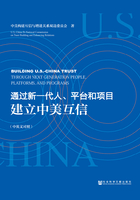
4.交流在建立互信中的重要作用
在2010年和2012年,德国马歇尔基金调查询问美国民众,美国和中国是否享有足够的共同价值和利益以合作解决国际问题。与对中国的日益增多的负面看法相一致,没有几个美国人认为中美间具有合作的价值观念和利益基础。尽管如此,2012年,仍然有46%的被调查者认为双方存在共同的基础。芝加哥全球事务委员会的调查显示,日益增多的(40%)美国人认为美国需要和中国建立新的伙伴关系。[39]
我们认为,缺乏足够的交流以及对于交流范围和所解决问题认识的欠缺,成为限制两国间合作潜力发挥的关键原因。更多和更有效的交流对于构建互信无疑是至关重要的。
信任包含三个层面的内容,即知道对方怀有良好的意图,是可以履行承诺的,行为是可以预期的。这是中美关系得以稳定发展的根本保障,因为它限制了双方对合作风险的看法,并抑制任何一方有损害信任的行为,例如缺乏交流、怀疑对方有隐含的目的,以及误解。[40]
交流是培养中美互信的关键要素。行为者拥有的有关彼此的信息的数量和质量有助于克服忧虑,不用担心在信任对方时犯下错误。[41]而正是相互交流才会深化合作。交流是取得信任的核心,因为交流可以解决信任的三个层面的问题:真实的交流显示了一方良好的意图,展示了能力,使得一方可以预期另一方的行为。有效的交流增进彼此的熟悉程度,加深相互理解,反过来促进双方为进一步的共同利益采取积极的行动。
许多分析人士在看待交流在国际关系中的作用时,聚焦传统外交接触,主要关注政府领导人和高层代表如何进行战略对话、高层互访及其他形式的私人交流。这当然是双边关系的重要部分,但值得记住的是美国和中国的领导人均受到来自政府内部和外部的影响和约束,他们致力于影响公众态度,但也要留意来自外界的影响。因此,政府和政府、政府和公众及公众和公众间的交流都对减少战略互疑至关重要。
在本报告中,我们审视两国政府和民众间存在的多重形式的交流:独白、对话与合作。[42]我们建议的方案一部分可能在短期内取得成效,但大多数需要长期的努力。我们建议利用新闻管理、战略沟通和建立关系的方式来发展有效交流的多重渠道。两国政府和民间力量已经开始了在有些方面的努力。我们提倡继续扩大和深化这些努力,提高成效,并且采纳本报告提供的建议以及成功的交流经验展开新的努力。
在我们提出建议之前,让我们先来回顾在六个领域(外交、教育、文化、媒体、商务和民间)里为建立互信正在进行的交流,明确有待发掘的机会,以培养双方更加深入的理解和互信。
[1] U.S. Office of Travel and Tourism Industries,“Forecast of International Travelers to the United States by Top Origin Countries.” China National Tourism Administration,“2012 Foreign Entries” (2012年1~12月入境旅游外国人人数)。
[2] U.S. Department of Commerce,“Trade in Goods with China.”
[3] U.S. Department of Commerce,“U.S. Direct Investment Abroad,Country Detail.”
[4] China National Bureau of Statistics,“6th National Census Results,2010;Hong Kong,Macau,and Foreign Population,” (2010年第六次全国人口普查接受普查登记的中国港澳台地区居民和外籍人员主要数据),April 29,2011。
[5] Thilo Hanemann,“Chinese FDI in the United States,Q2 2013 Update,” Rhodium Group,July 19,2013.
[6] For example,U.K. investment in the U.S. manufacturing sector was $140 billion in 2011. James K. Jackson,“Foreign Direct Investment in the United States:An Economic Analysis,” Washington,DC:Congressional Research Service,October 26,2012:3. U.S. Department of the Treasury,“Major Foreign Holders of Treasury Securities (as of May 2013).”
[7] Institute of International Education,“Open Doors Fact Sheet:China.”
[8] U.S. Department of State.“100,000 Strong Initiative.”
[9] Pew Research Center,“America’s Global Image Remains More Positive than China’s,” July 18,2013,p. 76.
[10] BBC World Service,“Views of China and India Slide While UK’s Ratings Climb:Global Poll,” May 22,2013,p. 3.
[11] Pew,“America’s Global Image.”
[12] Gallup Organization,“In U.S.,More See China as Friend Than Foe,” June 6,2013.
[13] Hu Qingyun,“Poll shows majority see US as friendly after summit,” Global Times,June 13,2013.
[14] Jeffrey M. Jones,“In U.S.,Majority Still Names China as Top Economic Power,” Gallup Organization,February 26,2013.
[15] Pew,“America’s Global Image.”
[16] Pew,“America’s Global Image.”
[17] Committee of 100,“US-China Public Perceptions,” April 2012,p. 37.
[18] Cynthia English,“Americans See the Benefit of Close U.S.-China Relations,” April 17,2012.
[19] Pew,“U.S. Public,Experts Differ on China Policies,” September 18,2012.
[20] Committee of 100,“US-China Public Perceptions,” April 2012,p. 31.
[21] German Marshall Fund of the United States,“Transatlantic Trends:Key Findings 2011,” “Transatlantic Trends:Key Findings 2012,” and “Topline Report 2012.”
[22] USC U.S.-China Institute,“Talking Points November December,2012.”
[23] Chicago Council on Global Affairs,“Global Views 2012,U.S. Public Topline Report.” July 27,2012,p. 69.
[24] Committee of 100,“US-China Public Perceptions,” April 2012,p. 48.
[25] See,for example,Chinese state media coverage of the June 2013 meeting between Xi Jinping and Barack Obama. E.g.,“The get-together,unparalleled in China-U.S. interaction,has produced a rich harvest of fruits,with the most striking one being the joint commitment to building the bilateral relationship into a new type of great power relations based on mutual respect and win-win cooperation.” Xinhua News Agency commentary published in People’s Daily and elsewhere,“Commentary:Xi-Obama summit opens new chapter in China-U.S. relations,” June 10,2013.
[26] Committee of 100,“US-China Public Perceptions,” April 2012,p. 48.
[27] Committee of 100,“US-China Public Perceptions,April 2012,p. 42.
[28] Committee of 100,“US-China Public Perceptions,” April 2012,pp. 102-105.
[29] Pew,“Public Priorities:Deficit Rising,Terrorism Slipping,” January 23,2012,p. 1;Pew,“Growing Concerns in China about Income Inequality,Corruption,” October 16,2012,p. 1.
[30] See Yunxiang Yan,“Food Safety and Social Risk in Contemporary China,” Journal of Asian Studies 71.3 (2012),pp. 705-729.
[31] For example,in 2012 81% of Americans told Gallup that “having a close relationship with China is a good thing.” Cynthia English,“Americans See Benefits of Close U.S.-China Relations,” Gallup Organization,April 17,2012.
[32] German Marshall Fund,“Transatlantic Trends:Key Findings 2011,” September 2011,p. 15.
[33] Frank Newport and Igor Himelfarb,“Egypt’s Favorable Rating in U.S. Slips to Two-Decade Low,” Gallup Organization,March 15,2013. Jeffrey M. Jones,In U.S.,More See China as Friend Than Foe,” Gallup Organization,June 6,2013.
[34] Pew,“America’s Global Image Remains More Positive than China’s,” July 18,2013,p. 11,29.
[35] Kenneth Lieberthal and Wang Jisi,“Accessing U.S.-China Strategic Distrust,” John L. Thornton China Center at the Brookings Institution,April 2012. Also available in Chinese as 《中美战略互疑:解析与应对》 from the Center for International and Strategic Studies at Peking University。
[36] Wang Jisi,“China’s Search for a Grand Strategy:A Rising Great Power Finds Its Way,” Foreign Affairs 90.2 (2011),pp. 68-79. The Obama Administration is developing a revised National Security Strategy. The U.S. National Intelligence Council also publishes its assessment of potential security issues in its Global Trends series. The most recent of these statements was published in December 2012.
[37] Maurice Greenberg,“Time for A China-U.S. Free Trade Agreement,” Wall Street Journal,January 9,2012.
[38] Wang Jisi,Qian Yingyi,Wang Min,Jia Qingguo,and Bai Chong’en. “In Search of New Thinking In China-U.S. Strategic Relations.” China Daily,February 6,2012.
[39] German Marshall Fund,“Topline Report 2012;” Chicago Council on Global Affairs,“Global Views 2012 Topline Report.”
[40] Aaron M. Hoffman,“A Conceptualization of Trust in International Relations.” European Journal of International Relations 8,no. 3 (2002):375-401.
[41] Hoffman,“A Conceptualization of Trust in International Relations.”
[42] Geoffrey Cowan and Amelia Arsenault,“Moving from Monologue to Dialogue to Collaboration:The Three Layers of Public Diplomacy,” The ANNALS of the American Academy of Political and Social Science. March 2008. vol. 616,no. 1∶10-30.